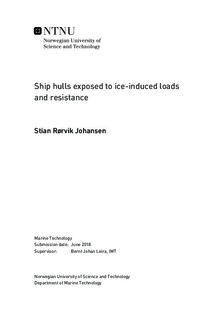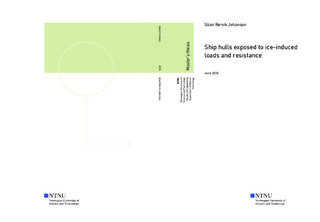| dc.description.abstract | Marine activities in the Arctic have always been difficult. In recent year there have been
a significant increase in activities in this region. This is a combined result of both global
warming and a strong development in the design and the technology for ice-classified
vessels. Arctic transportation routes, exploration of hydrocarbons and tourism are all
exiting opportunities related this development.
This master thesis contains a theoretical study sea ice. In addition to a introduction
to ice covered areas, both different types of sea ice and their mechanical and physical
properties are presented.
In this master thesis, KV Svalbard will be used as a reference. This is a Norwegian coast
guard vessel, specialized for operations in Arctic waters.
To operate in ice-infested waters, the right classifications are necessary. In these areas
the vessels are exposed to conditions they would not experience in other regions, and
special classifications for navigation in ice are therefore developed. This thesis contains
a review of the classifications presented in DNV GL s "Ship for navigation in ice". Here,
both Baltic, Arctic and Polar classes are described. Since the Arctic region has been in
focus for this thesis, a particular emphasis has been placed on the Arctic rules by DNV
GL and the Polar rules by IACS.
An introduction to finite element analysis is presented. Linear and non-linear analysis
are described and compared. In the event of ship-ice interaction, large displacements
and deformations may occur. Here, linear elastic theory may no longer be valid, and
non-linear theory must be applied.
To estimate the ice resistance for a vessel, analytical formulations may be used. In this
master thesis, three models are presented and compared. All of the formulations are
meant to give an early estimation of resistance for ice and power requirements. By
using the main parameters from Norwegian coast guard vessel KV Svalbard, the three
models are compared to each other. In addition, a parameter study for the models was
conducted to see how each of the parameters involved influenced the final results.
Using the measured power from KV Svalbard, the total resistance was calculated utilizing
Newton s second law and conservation of energy. This resistance was then compared
by calculating the ratios between estimated and empirical resistance. From the
results one can see a big variation in the ratios. The most stable results were found for
higher vessel speeds.
To see how ice loads affect local parts of a hull, a plate model was created and analyzed
using Abaqus. As for the resistance, KV Svalbard was used as a reference. This
vessel has ice classification Icebreaker Polar 10, and using this classification, values for
stiffener dimensions, load height and ice pressure were obtained. In addition to the
ice pressure from DNV GL, an empirical ice pressure was used in the analysis. Not all
parameters involved in the analyzes were defined according to regulations, but chosen
arbitrary. As a consequence, there are some uncertainty connected to the results.
To see how modifying different values would affect the final response of the panel, a
parameter study was conduced. The parameters modified were contact area, stiffener
spacings and dimensions, and load angles. From the results, one can see a clear difference
between the results for the different ice pressures. Using the DNV GL ice pressure,
stresses above the yield strength of the material will occur, leading to plasticity. | |

